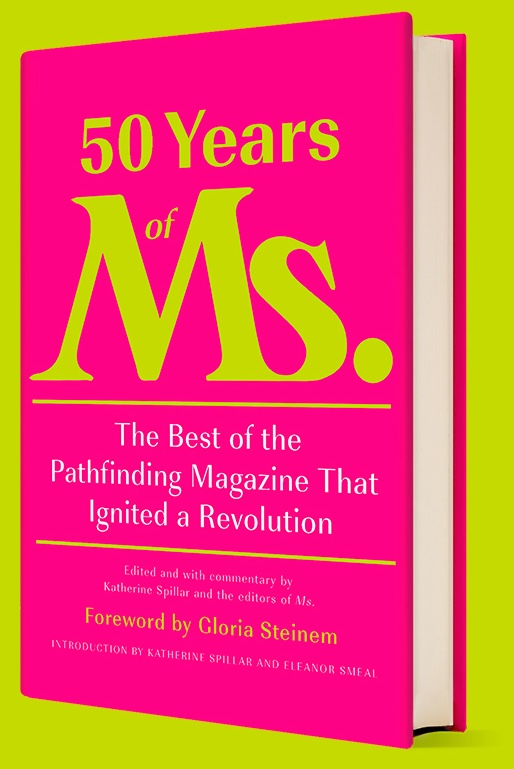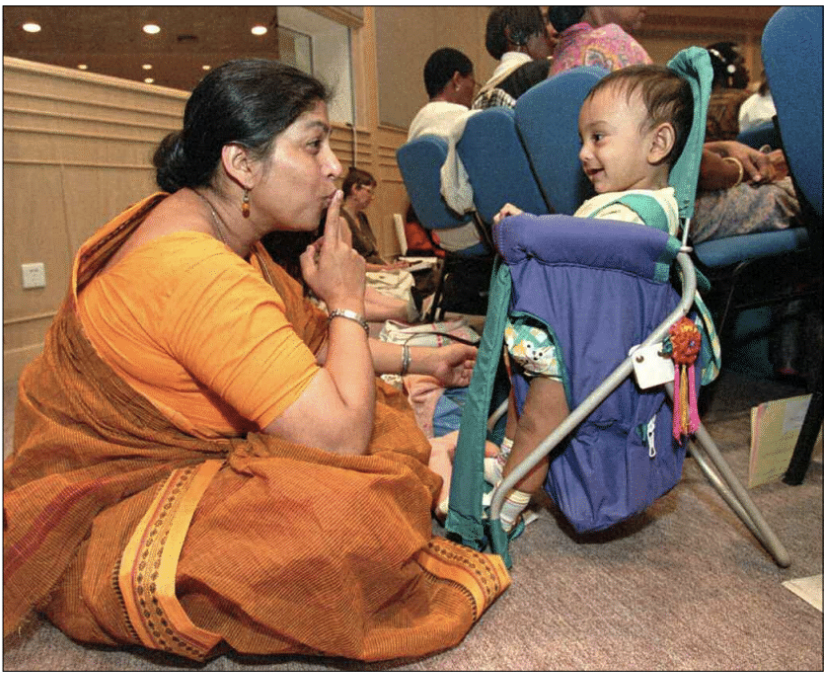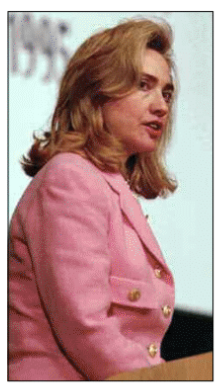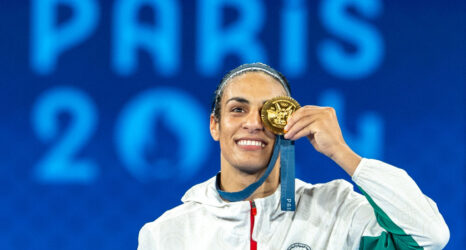
To pay tribute to five decades of reporting, rebelling and truth-telling, From the Vault includes some of our favorite feminist classics from the last 50 years of Ms. For more iconic, ground-breaking stories like this, order 50 YEARS OF Ms.: THE BEST OF THE PATHFINDING MAGAZINE THAT IGNITED A REVOLUTION (Alfred A. Knopf)—a stunning collection of the most audacious, norm-breaking coverage Ms. has published.

Remember the story about conflicting definitions of an elephant, each by someone describing a different part? Those are the varied reports about the United Nations Fourth World Conference on Women (September 4–15, 1995) and the overlapping NGO (nongovernmental organizations) Forum on Women ’95 (August 30–September 8). But most would agree that the Platform for Action emerging from the conference is remarkable—a document that, even with its flaws, is the strongest official statement on women internationally to date.
This triumph was at least 20 years in the making. Momentum built during the 1975–85 U.N. Decade for Women (the Mexico City, Copenhagen and Nairobi women’s conferences), and women declined to disperse obediently at the decade’s end; instead, we intensified both grassroots organizing efforts and NGO pressure on governments.
Furthermore, women broke out of the ghetto and mobilized regarding the U.N. general conferences: The Conference on Environment and Development (Rio de Janeiro, 1992); the World Conference on Human Rights (Vienna, 1993); the International Conference on Population and Development (Cairo, 1994); and the World Summit for Social Development (Copenhagen, 1995) all witnessed the growing presence—and clout—of women.
At each of these conferences, a daily Women’s Caucus, organized for NGOs by the Women’s Environment and Development Organization (WEDO), directed and focused on-site sophisticated lobbying efforts so that government delegations were forced to realize that all issues are “women’s issues.”
Meanwhile, women were painstakingly learning the complex ways of the U.N. and how to make an impact on its policies. Groups went through the process of application for accredited NGO status; activists dragged themselves to the numerous regional preparatory meetings that precede each conference, where the real work of affecting content and agendas takes place and from which the draft document emerges.
They learned that by the time that draft actually goes to the conference for which it’s intended, it’s not likely to be substantively changed, and that the time for lobbying governments with new input is by then past. They also learned to push hard for the inclusion of NGO representatives on government delegations. It was the most organized international effort to date.
But first, the forum, since it began first. This report is a mix of facts, analysis and the generously shared thoughts of old and new friends from around the globe. You probably shouldn’t feed it peanuts.
The Platform for Action emerging from the conference is remarkable—a document that, even with its flaws, is the strongest official statement on women internationally to date.
The Form: Spins, Security, Sisterhood
The good news: 30,000 women “rose above it.” The bad news: We had to. The plain truth: Men would never have tolerated such treatment. Women did—not necessarily something to be proud of.

A spin has emerged in forum post-mortems that accentuates the positive to a ludicrously inaccurate degree. It claims that only feminists from northern countries complained about the forum planners or Chinese-government attempts to control thousands of grassroots activists.
But there were equal opportunities for outrage: African women charging their Chinese hosts with racist attitudes; South Asian women protesting visa delays/denials; Latin Americans complaining of arbitrary detentions; Middle Easterners appalled at some of the overcrowded, even unsanitary, Huairou living accommodations; Pacific Islander women infuriated at the Chinese press for censoring their hottest issue, French nuclear testing. (China also conducts nuclear tests, remember.)
Frankly, it’s an act of disrespect to Chinese women—all the non-hand-picked, non-Stepford feminist ones we never got to meet—to pretend that the Chinese government was the dandiest host conceivable and that China’s just a developing nation that did its best, gee whiz. China’s also a world power, by golly—and judging from all the semi-pornographic billboards promulgating multinational corporate products—its government lusts after the worst the West offers while fearing the best, such as even a pretense of free speech.
When Kenya (a developing nation that’s not a world power) hosted the 1985 Women’s Conference and Forum, the Kenyan government, unlike the Chinese, didn’t issue warnings to its citizens to be wary of these foreign radicals who might run around naked and be HIV/AIDS positive.
See, the Beijing Boys really wanted the Olympics in the year 2000. Losing out because of their human rights record made them cranky, so the U.N. awarded a consolation prize: us. But hordes of political women instead of reams of apolitical athletes were maybe less their compensatory ideal than their worst nightmare.
Wistfully pretending that gold medalists, not feminists, were advancing on the Forbidden City, they based the U.N. Conference next to Beijing’s Asian Games Village and staged epic ceremonies, with torch-passing at the National Olympic Sports Center Stadium, fashion shows (huh?), martial arts teams, and battalions of heavily lipsticked children costumed as matadors (huh?), dancing or releasing thousands of stoned doves dizzy from being released for such spectacles. (The acrobats were fabulous, and the Chinese Women’s Philharmonic impressive, although there are just so many times you can appreciate Beethoven’s “Ode to Joy” in one three-day period.) Red carpets (literally) and interpreters who actually spoke languages other than Mandarin were reserved for the conference.
Uneasy with the non-governmental concept, the Chinese government exiled the forum from its planned Beijing site to “scenic” Huairou, more than 90 minutes (in rain, more than two hours) away. NGOs threatened to boycott.
But forum officials reassured NGOs of government guarantees: Excellent lodging and communications facilities would be built for those staying in Huairou, and buses would shuttle every 20 minutes between Huairou and Beijing.
Fits of mirth. Specially constructed buildings lacked walls and roofs. Only toward the forum’s end, after women got blessedly “shrill,” did buses appear every half hour—sort of. “Volunteer Guides” were politely unfamiliar with Huairou and with any non-Chinese language. Workshop venues were changed with no notice and the Official Schedule listing the almost 5,000 workshops lacked an index.
Honest. Tent-area “paths”—thin concrete squares laid without fixative on bare earth—turned graham-crackery with rain and sank in the surrounding mud. Draconian “security” measures were not exaggerated by the Western press; uniformed and plainclothes police, body frisks, room searches, confiscation of literature/videos/signs; “appointed” hotels and “designated” restaurants (quality control or female control?); even a “regulated” protest area: a playground.
Why did women endure such treatment? For each other’s sake. (This is how they get us.)
Here’s another montage:
A virtual city of female people. Turbans, caftans, saris, sarongs, kente cloth, blue jeans. Workshops—on micro-credit, caste, women’s studies, “comfort” women, solar stoves, refugees, you name it. Round-the-clock networking. Nonstop cultural events. A “once and future pavilion” demystifying men’s technology and celebrating women’s alternative technologies. First-timers, euphoric at the sheer numbers, finally feeling part of a vast global movement. Veterans delighted that “cultural defense” justifications finally wilted under a unifying assault against purdah, sexual slavery, polygyny.
Special honors go to a triad that emerged in spontaneous leadership:
- disability NGOs, outraged at crumbly paths, workshop assignments to second-floor, no-elevator venues, and too-steep ramps—“for ski-jumping, not chairs,” quipped one Filipina feminist on wheels; they daringly staged the first demonstration outside the “designated protest area,” an energetic roll-in.
- The U.S. Women of Color coalitions—a de facto microcosm of the world’s women, but with a shared language, and experience in alliance-building—who found themselves ascendant as coalition facilitators. And
- lesbian activists, who exuberantly staged the first march (far from the designated playground, kiddo), chanting “Liberté, Egalité, Homosexualité.” This set the tone for other breakout demos—a daily defiance teaching the Chinese police how to study their shoe-tips intently.

More than 1,000 women united for the Women in Black vigil on violence against women, organized by Asia-Pacific groups. (How I somehow wound up making and carrying the sign reading “Don’t Forget the Women of Tiananmen Square”—and my experience afterward—is another story. I’d been trying to be good. But authoritarian regimes bring out the 1960s in me.)
Meanwhile, back in Beijing, the conference suffered from a minor epidemic of “first ladies.” Hillary Rodham Clinton deserves praise for facing down the U.S. right-wing by going to China and speaking substantively both in Beijing and Huairou. But more than one delegate (names tactfully withheld) conveyed discomfort that the drive toward women holding power directly was subtly undermined by the presence of at least 16 first ladies.
Of the (fewer) female heads of state or government, Pakistan’s Prime Minister Benazir Bhutto delivered the most virtuoso speech. In this juggling act, she deftly:
- decried fundamentalism, while defending Islam from accusations of misogyny;
- affirmed the “traditional family as the bedrock of society,” while attacking female infanticide as the cause of the current sex imbalance in more than 15 Asian countries; and
- defended cultural values, while announcing that Pakistan would become a signatory to CEDAW (the U.N. Convention on the Elimination of All Forms of Discrimination Against Women).
And her visual subtext! Bhutto’s usual elegantly draped head scarf—her chic gesture to the hijab—was unsecured over her sleek hair, so that it slipped backward, a millimeter at a time, with each nod of her head. This double message to the mullahs back home magnetized every gaze present. Riveting suspense: Would she catch it before it slid off completely? At the last possible moment, with the barest riddle of a smile, she’d resettle her chiffon banner—only to have it promptly begin its slippage again.
The best “position paper” was the single page signed by Marye Kat and Meike Keldenich (ages 12 and 11), members of the Netherlands delegations:
“Most of you promised to [include youth in delegations]. … Now, as far as we know, we are again the only ones. If you don’t do what you have promised, how can we believe you [will] do what you are promising now at this conference?”
These girls have a political future. So does the Netherlands.
The general terminology reflected a conceptual shift. Words once risked only by radical feminists have entered the policy mainstream. I can remember being criticized for using “oppression,” “liberation,” and “power”—as opposed to the less threatening “discrimination” and “equality”; Bhutto’s speech included all five of those words. I remember buttons reading “All Women Are Working Women” (for a 1970s welfare rights demonstration), and how we had to explain that shocking concept. Now, there it was, in bold letters, on the front of the U.N. International Labour Office press packet.
Which brings us to the Platform for Action itself. The draft document was strong; activist NGO women had helped write it, remember, at five regional prep-cons. But the fundamentalist Christian-Islamist-Vatican coalition, availing itself of U.N. procedure, imposed brackets around text it deemed controversial, so the draft went to Beijing with a substantial third of it caged in so-called Holy Brackets.
The first brackets melted away through negotiated compromise language in closed-session trade-offs between delegates. Then the conservatives dug in. Finally, three forces prevailed, working in tandem through all-night sessions: the European Union; the Scandinavian countries (decried in fundamentalist leaflets as the “Satanic Nordic Group”); and especially the Group of ’77, the major coalition from the South, skillfully chaired by the Philippines’ Senator Leticia Shahani.
So 189 countries adopted the final Platform for Action and its shorter preamble, the Beijing Declaration, by consensus. There’s too much abstract language, yes: too little on resource allocation, institutional reform, implementation—although more than 90 governments committed to specific actions. The wording is bland on many points, including the right to inheritance. And we failed to retain the phrases “sexual orientations” and “sexual rights.”
Still. We consolidated, even broadened, gains won previously.
Paragraph 96:
“The human rights of women include their right to have control over and decide freely and responsibly on matters related to their sexuality, including sexual and reproductive health, free of coercion, discrimination, and violence.”
Many countries pledged voluntarily to interpret lesbian rights as covered under paragraph 46, which recognizes that women face additional barriers to full equality, such as race, age, ethnicity, culture, disability, because they are indigenous, or “because of other status.” Not good enough. But a great stagger forward.
The document also criticizes structural adjustment programs; advises cuts in military spending in favor of social spending; urges women’s participation at all peace talks and in all decision-making affecting development and environment; confronts violence against women; calls for measuring women’s unpaid work; and refers to “the family in its various forms.”
Bringing It All Back Home
“This document is a contract with the world’s women,” says our own former Congresswoman Bella Abzug, a major voice at both the forum and conference.

Unenforceable in a strict legal sense, the plan nonetheless sets precedents, exerts a political force, and can act as a lever. If we use it. Since China was the first country in all my travels where I’d been unable to contact nonofficially approved women (feminist independents and dissidents had been sent well out of the Beijing/Huairou area), I left frustrated.
On my way home via Hong Kong, I read of a cigarette-lighter factory explosion in Dunde City, Guangdong—a tragedy that had left 60 women workers critically injured and more than 20 burned to death. Hong Kong–based unionists had entreated the Chinese government to lift the media ban on such accidents, and had appealed to the conference and forum, desperate to draw attention to conditions that mainland women factory workers face. Not one word of this tragedy had ever reached us in Beijing or Huairou. My anger at the government’s treatment of international activists refocused, fittingly, to its treatment of Chinese women—20 percent of all female people on earth.
But wait. Nearly 60 percent of China’s population is under 25, and half (despite the resurgence of female infanticide) is female. There’s a growing divorce rate—it’s doubled in Beijing over the past four years—and 70 percent of divorces are women-initiated. Since it’s women who hold up half the sky, the Chinese government should read the story of Chicken Little.
Up next:





